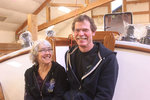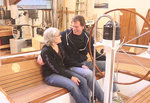John and Ann Bailey of Port Townsend are completing the restoration of a 49-foot schooner, Sir Isaac, which they plan to launch March 15 at Boat Haven.
"Ted Pike found it for us," John said. "It …
This item is available in full to subscribers.
We have recently launched a new and improved website. To continue reading, you will need to either log into your subscriber account, or purchase a new subscription.
If you had an active account on our previous website, then you have an account here. Simply reset your password to regain access to your account.
If you did not have an account on our previous website, but are a current print subscriber, click here to set up your website account.
Otherwise, click here to view your options for subscribing.
* Having trouble? Call our circulation department at 360-385-2900, or email our support.
Please log in to continue |
|


John and Ann Bailey of Port Townsend are completing the restoration of a 49-foot schooner, Sir Isaac, which they plan to launch March 15 at Boat Haven.
"Ted Pike found it for us," John said. "It was never for sale ... it had been on the hard for years."
That was in 2001. Pike flew to California with them when they went to look at Sir Isaac, hauled out at Svendsen's Boat Works in Alameda.
They had it delivered to Port Townsend on a truck, and sailed it for five years. They undertook a few Round the County races and a Swiftsure race before embarking on the restoration; they wanted to determine if it was worth the time and money.
The first summer, they sailed it without an engine. "That's how you best learn a boat," John said.
IRIS WAS FIRST
This isn't the Baileys' first boat – that was Iris, a 43-foot yawl on which they sailed the Pacific from 1990 to 1995, visiting far-flung islands as well as Australia and New Zealand. In a photo taken at Penrhyn atoll in the Cook Islands, Ann wears a hat. "All women had to wear hats on Sundays," John recalled.
Iris had few amenities – no refrigeration, no hot water, no water pressure; the couple showered on deck with a sun shower.
"We started out with just a sextant. It was old-school navigation when we left," John said. "We caught all of our own water for drinking for five years." They used buckets, and had several awnings that captured water.
They first came to Port Townsend by water, arriving in 1981 on Iris for some minor repair work to the boat, which turned out to be major. Iris had to be reframed, and have all topside planking, the stem, transom and floor timbers replaced. The Baileys did that work in six months, with help from John's brother.
ON TO SIR ISAAC
Their sailboat Sir Isaac is much more luxurious than Iris, with comforts such as hot water and refrigeration.
"We'll have a heater. We've never had a heater while cruising," John said. The hydronic heating system has a diesel furnace to heat water that flows to radiators.
They added a double berth; Sir Isaac now sleeps seven people, though the couple had 11 on board for a Round the County race, with one person sleeping on sail bags up forward, and "people absolutely cram packed on the cabin sole," Ann said.
Sir Isaac's gleaming varnished interior paneling is all made from one big sapele board. John took up some floorboards to show the varnish all the way to the keel. Every square inch of Sir Isaac glows and shines; the attention to detail is remarkable.
"For the first time ever in my sailing career, we have pressure water and hot water," said John. He's a longtime sailor; his mom wrote the popular cruising guides "Gunkholing in the San Juan Islands" and "Gunkholing in South Puget Sound" books.
"Sir Isaac slips through the water effortlessly," John said. He loves heavy-weather sailing, he said, but one of his favorite sails aboard Sir Isaac was on a light-air day. Sailing back to Port Townsend from the San Juan Islands, the water was flat, with "a little tiny bit of breeze up high, and we sailed back at about 2 knots," he said. "Complete quiet ... it was so calm. It was just an effortless sail back. You can hear the water rippling on the hull. You can hear the little splash when the ducks dive – ploop!"
CRUISER-FRIENDLY
"We've made it more cruiser-friendly," John said of Sir Isaac. Fuel capacity, which was previously 40 gallons, now is 100 gallons. They added a water tank, increasing capacity to 150 gallons.
When John was cleaning out the chart table, "way, way back in the recesses," he found a little bronze plaque that reads "C&B Marine Boatbuilders, Sir Isaac, May 1984, Santa Cruz, California." He cleaned it up and installed it near the main companionway.
The Baileys changed the design of Sir Isaac to add some headroom in the cabin and they changed the shape of the stern a little. "It used to dive down," John said. They "made it a little more what we wanted to see in a boat ... we've always been a little more traditional."
Photos of Sir Isaac under sail show masts of equal height. "It's called a modern schooner," John said. It has a modified fin keel, a little longer than what a race boat would have, John said. They're having Port Townsend Rigging taper the aluminum masts, and are adding 2 feet to the mainmast.
In early February, John was working on fuel filters and a fuel manifold. He's a marine engineer by trade; he worked for Washington State Ferries, a job he left in 2014 to finish Sir Isaac. Ann works as a nurse at Jefferson Healthcare.
The engine box for the 50-horsepower Yanmar is under the galley sinks in the wide cabin; the boat's beam is 13 feet. There's a gimbaled propane Seaward stove with a gimbaled counter space, large enough for a few mugs, beside it. Gimbals keep things level when the boat heels, so even when the boat is heeling on a steep angle, the gimbaled stove and counter stay level.
As the Baileys talked about the galley, Ann opened a drawer and found a dramatically curving wooden spoon carved of yellow cedar and mahogany. "He carved this spoon on our very first sailing trip together, when we were first sparking," said Ann, and suddenly the cabin felt a little too warm.
John, 60, is from Olympia; Ann, 59, was raised in Iowa. Both competitive swimmers, they met at the Ballard Pool in 1979 and have been swimming together ever since. They do a lot of ocean swimming, taking part in open-water events; they spent many hours each day in the water on their Pacific trip on Iris.
The Baileys don't have definite plans for Sir Isaac.
"We don't know what we're going to do," Ann said.
"We're going to learn how to sail her again," John said. "Take little trips."
"We have lots of ideas," Ann said.
SECOND OWNERS
Sir Isaac was built in 1984 in Santa Cruz, California, for Rod Holt, from whom they bought the boat in 2001. "He was Steve Jobs' first engineer at Apple Computers," John said.
Sir Isaac was designed by Chuck Burns to be an performance cruiser for two people. "In its day, it was used for double-handed ocean racing," John said.
The cold-molded hull is 2 inches thick, built of one Port Orford cedar tree cut into thin strips and laid up in diagonal crisscrossing layers, except the outer layer, which runs fore and aft.
"Ann and I have done most everything on this boat ourselves," John said.
"When we bought the boat, we knew the deck was going to have to be replaced," John said. "We did not know the cockpit and cabin top needed to be replaced; that the keel had to be re-bedded. This is what happens. A project grows."
The Baileys replaced the deck and built a new cabin top with 24 sheets of 6-millimeter plywood using the "vacuum bagging" technique. The luxurious cockpit, with its two long, comfortable curved teak benches, is also vacuum-bagged.
Russell Brown, builder and sailor of innovative performance boats, has been a mentor, said John, who had to learn a lot about epoxy work for Sir Isaac. Robert d'Arcy, a Port Townsend shipwright, also helped with the cabin top, and Brian Young facilitated the layout of the cabin top design. Some new sails are to be made by Ballard Sails.
There are 12 winches in the cockpit; John rebuilt the winches in 2008 and lately has been installing them for fun after working all day on the boat. "After 5 p.m., I start putting fun stuff on," he said, spinning the sheaves in a big Harken turning block to hear the clicking sound that evokes bringing in a jib.
"We're reusing every bit of equipment that we can," John said. "It's a tremendous undertaking."
"He's polished every screw, every hinge, every latch," Ann said.
They hauled out Sir Isaac to start this project on March 16, 2006 and are launching at 3 p.m., March 15, 2016, just shy of 10 years later.